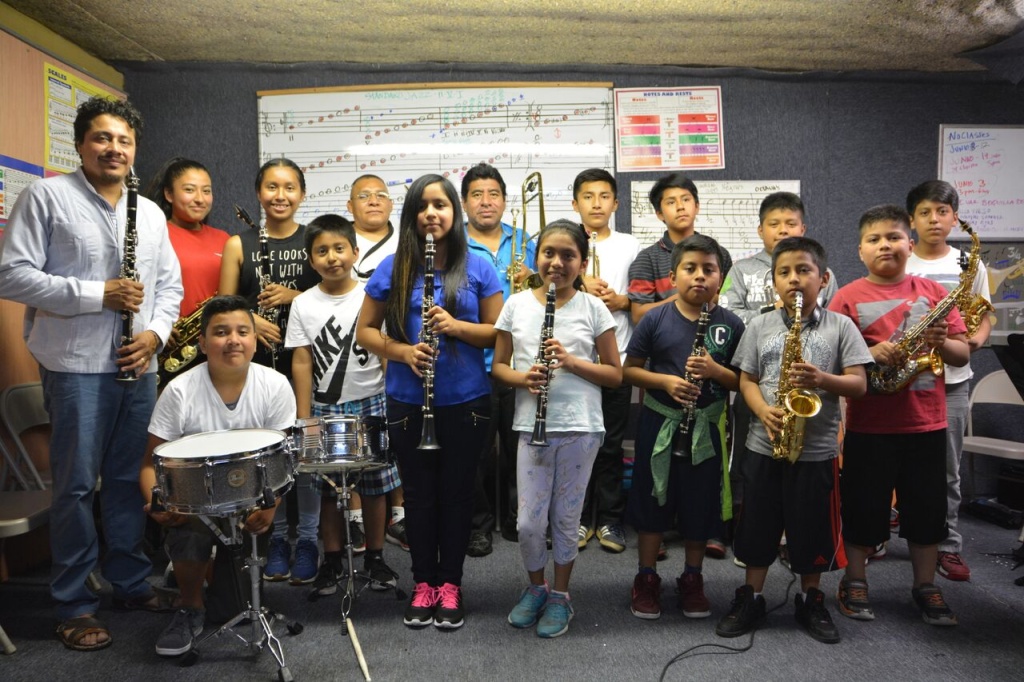Oaxacan traditions live on in LA through music schools


Los Angeles is home to the largest number of immigrants from the Mexican state of Oaxaca. The LA Oaxacan community has a rich musical culture, supported in part by a tradition of schools that promote music education through brass bands.
Two years ago, Esteban Zúñiga had to stop teaching music in his garage. His neighbors kept calling the police and he was repeatedly fined. He went to court, and the judge dismissed the fines. But to stay out of trouble, he decided to save money from his landscaping job to soundproof the garage.
“It’s a lot, it’s a lot of investment. Why? Because it’s community work. It’s for our culture. I prefer my community or the descendants learning their culture, instead of being in the streets or getting hypnotized by the technology that we have,” he said.
Tonight, in that soundproof garage, complete with air conditioning and a bathroom, Zúñiga teaches a group of fifteen students, ranging in ages eight to sixteen. Saúl Martinez is one of Zúñiga’s students. He’s eight years old and plays soprano saxophone.

Norma Policarpo is Saúl’s mother. She’s been bringing her son to Zúñiga’s music school for the past ten months. She says Saul puts a lot of effort into it, learns more every day and is persistent. She’s seen his progress, that’s why she keeps bringing him — that, and the fact that her son is learning Oaxacan customs, and keeping its traditions alive.
Esteban Zuñiga and other teachers like him are replicating a tradition from Oaxaca called “Escoleta”: A music school based in a village.
“Each village has one. The most important thing is, once they have an Escoleta, it’s music for everybody in their hometown, basically free, so they can keep passing the musical tradition,” said Zuñiga.
That musical tradition is focused on the brass band, usually made up of twenty to thirty-five instruments — trumpets, trombones, sousaphones, along with clarinets, saxophones, and two drums. Here in Los Angeles, there are more than a dozen Oaxacan brass bands, and each has its own Escoleta.
Zuñiga is preparing his students for a new brass band he’s forming. They’ve been practicing for six months. Once he’s worked with them for about a year, he says they’ll be ready to play in public.
Two miles from Zuñiga’s garage, there’s a storefront on Pico Blvd. Maqueos Music Academy is home to a thirty-piece brass band and a large dance troupe. They’re rehearsing for a traditional music and dance festival called Guelaguetza.

Estanislao Maqueos was director of his hometown’s municipal brass band. He moved to LA in 2000. After a few years working odd jobs and gaining the respect of the local Oaxacan community, he established his music school. Since then, he’s helped form several brass bands.
“It’s difficult for the children because they were born here and it’s another culture,” Maqueos says. “We’re imposing our children to play our music and it’s hard, but after so much persistence, they do learn to love our Oaxacan music, they dance to it, and they make it their own.”
Maqueos says the goal is to help their children find their identity: “Even though they were born in this country, their roots are in Oaxaca, the roots of their parents are there, and part of their identity is this music.”
Oaxacan brass bands play at all kinds of private and public events — from religious processions to dance festivals. Tonight, at the home of Maqueos Music Academy, there’s a party celebrating a baptism.

Nineteen year-old Yulisa Maqueos is directing the band. She plays clarinet and is the daughter of Maestro Maqueos. She says her father has built an impressive body of work.
“As immigrants, we come here with nothing and we work hard, and seeing how someone from the pueblo can actually succeed in any other way that a citizen could do it… I think it just gives me a feeling of hope that everything is possible.”
There are people who call Maqueos Music school “the hotbed” of brass bands in Los Angeles. In seventeen years, Maqueos has taught music to more than five hundred students. Still, he says he has bigger dreams: “I want to have a big band with strings, a complete symphonic orchestra.”
